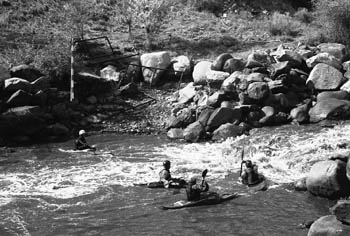by Missy Votel
 Kayakers with visions of a new-and-improved Smelter Rapid turning
cartwheels in their heads will have to wait another season for
the changes.
Kayakers with visions of a new-and-improved Smelter Rapid turning
cartwheels in their heads will have to wait another season for
the changes.
After several months on the drawing board,
improvements to Durango’s whitewater park, which were slated
to take place this fall, have been postponed for at least a year.
And while the delay is partly the result of this summer’s
fires, which sapped the city’s resources, Cathy Metz, Durango’s
director of Parks and Recreation, said it is more a product of
wanting to get it right.
“Sometimes it’s better to do
your homework up front,” she said. “We had a couple
of public meetings and had a set of plans, but it wasn’t
quite what people wanted.”
The desire to take it slow and incorporate
all stakeholders in the process arose after a group of local kayakers,
with help from the city, attempted to improve whitewater features
on the river in 2001. Although some changes, such as the addition
of the Corner Pocket hole below Smelter, were well received, others,
such as those done in the Smelter drop, were altered by high water,
creating dangerous hydraulics at certain levels.
Grumblings from the local environmental community
as well as river users caused the city to reevaluate its approach
to river work. As a result, the city hired Boulder-based engineer
Gary Lacy, who has built whitewater parks in Steamboat Springs,
Golden, Salida and Farmington, to consult on the new plans. The
city also hosted a number of public meetings to gauge response
to the new set of plans.
“To the city’s credit, they’ve
worked hard to get raft companies, environmental representatives,
slalom boaters, play boaters and all sorts of river users to pore
over the plan,” said Kent Ford, former world champion kayaker
and member of the Board of Directors for the newly resurrected
Friends of the Animas River.
Lacy met with the public last February to
gather ideas and again in March to unveil his draft plan. The
city held another public meeting in August to further fine tune
the plan. Also, at the urging of FOAR, an effluvial geomorphologist
was brought on board to study the effects of the changes on the
river bed.
“We wanted to make sure it was done
in accordance with good science and bringing in the right scientists,”
said Anders Beck, director of the local river watchdog group.
As a result, final details of the plan – which includes
removal of the rock island that creates the “sneak”
to river left as well as the pile of undercut rocks not so affectionately
known as “Allen’s Pile” to river right –
are still being hammered out. Meanwhile, the window of opportunity
granted from the Army Corps of Engineers for the months of September
and October is quickly closing, and the work will have to wait
until next year.
Metz said the latest set of revisions have
been sent back to Lacy, and the final plans will be presented
to the public when available. Attempts to reach Lacy on when this
might be were sabotaged by poor cell-phone service.
Despite the wait, Ford said taking a cautious
approach to the plans is warranted.
“It makes sense because there are a
lot of users of the river, so balancing the needs of those groups
is worth taking the time,” he said.
However, he also pointed out that Mother
Nature will have the ultimate say in the plans, and that those
who think this will be a final fix for the river may be in for
a surprise.
“The city has a dream of doing it once
and being done with it,” he said. “But I think that’s
unlikely. This is a high-volume river that rolls rocks around,
and it will need periodic maintenance from time to time.”
|

